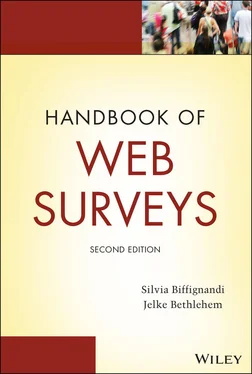Web surveys are a next step in the evolution process of survey data collection. Collecting data for compiling statistical overviews is already very old, almost as old as mankind. All through history, statistics have been used by rulers of countries to take informed decisions. However, new developments in society always have had their impact on the way the data were collected for these statistics.
For a long period, until the year 1895, statistical data collection was based on complete enumeration of populations. The censuses were mostly conducted to establish the size of the population, to determine tax obligations of the people, and to measure the military strength of the country.
The first ideas about sampling emerged around 1895. There was a lot of discussion between 1895 and 1934 about how samples should be selected: by means of probability sampling or some other sample selection technique. By 1934 it was clear that only surveys based on probability sampling could provide reliable and accurate estimates. Such surveys were accepted as a scientific method of data collection.
Somewhere in the 1970s another significant development started. The fast development of microcomputers made it possible to introduce CAI. This made survey data collection faster, cheaper, and easier; it also increased data quality. It was time in which acronyms like CATI and CAPI emerged.
The next major development was the creation of the Internet around 1982. When more and more persons and companies got access to the Internet, it became possible to use this network for survey data collection. The first Internet surveys where e‐mail surveys. In 1989 the World Wide Web was developed. In the middle of the 1990s, web surveys became popular.
Web surveys are attractive because they allow for simple, fast, and cheap access to large groups of potential respondents. There are, however, also potential methodological problems. There are ample examples of web surveys that are not based on probability sampling. It is not always easy to distinguish good from bad surveys. Attention to the methodological aspects is important both to run web surveys and to use web survey data.
The diffusion of mobile devices, especially smartphones, offers a recent attractive tool to reach interviewee for mobile web surveys, i.e., surveys where the contacted unit can receive and respond using either desk and portable computer or mobile devices. There are however methodological problems to be considered when applying mobile web surveys.
Current digital environment and technology trends are providing a huge amount of data about most phenomena. These data are available on the web and are based on the automatic collection on everything that people do; they are usually called big data; they are not subject to statistical classification criteria and to statistical treatment for representativity. However, they look like an attractive source of data to practitioners and researchers. They are wondering if big data could substitute web surveys to provide information for social and economic decision making. They will not substitute surveys; the message is that the two sources are complementary, but they require the researcher to consider the existing methodological problems. The big data offer a challenging opportunity to revise the role and questions faced from the surveys and to integrate web survey data with other data sources.
Blaise:A software package for computer‐assisted interviewing and survey processing developed by Statistics Netherlands. Census:A way of gathering information about a population in which every element in the population has to complete a questionnaire form. Computer‐assisted interviewing (CAI):A form of interviewing in which the questionnaire is not printed on paper. Questions are asked by a computer program. Computer‐assisted personal interviewing (CAPI):A form of face‐to‐face interviewing in which interviewers use a laptop computer to ask the questions and to record the answers. Computer‐assisted self‐administered questionnaires (CASAQ):A form of data collection in which respondents complete the questionnaires on their own computer or device. See also CASI. Computer‐assisted self‐interviewing (CASI):A form of data collection in which respondents complete the questionnaires on their own computer or device. See also CASAQ. Computer‐assisted telephone interviewing (CATI):A form of telephone interviewing in which interviewers use a computer to ask the questions and to record the answers. E‐mail survey:A form of data collection via the Internet in which respondents are sent a questionnaire that is part of the body text of an e‐mail. The questionnaire is returned by e‐mail after answering the questions in the text. Face‐to‐face interviewing:A form of interviewing where interviewers visit the homes of the respondents (or another location convenient for the respondent). Together, the interviewer and the respondent complete the questionnaire. Mail survey:A form of data collection where paper questionnaire forms are sent to the respondents. After completion of the questionnaires, they are returned to the research organization. Mobile web survey:Self‐administered surveys that can be conducted over mobile web‐capable devices. They are similar to web surveys, but they have also unique features, such as administration on small screens and keyboards, different navigation, and reaching respondents in various situations, factors that can affect response processes. Probability sampling:A form of sampling where selection of elements is a random process. Each element must have a positive and known probability of selection. Purposive sampling:A form of non‐probability sampling in which the selection of the sample is based on the judgment of the researcher as to which elements best fit the criteria of the study. Quota sampling:A form of purposive sampling in which elements are selected from the population in such a way that the distribution of some auxiliary variables matches the population distribution of these variables. Random digit dialing (RDD):A form of sample selection for a telephone survey where random telephone numbers are generated by some kind of computer algorithm. Representative method:A methods proposed by Anders Kiaer in 1896 to select a sample from a population in such a way that it forms a “miniature” of the populations. Straw poll:An informal survey conducted to measure a general feeling of a population. Sample selection is such that it usually does not allow concluding about the population as a whole. Survey:A way of gathering information about a population in which only a sample of elements from the population has to complete a questionnaire form. Telephone interviewing:A form of interviewing in which interviewers call selected persons by telephone. If contact is made with the proper person and this person wants to cooperate, the interview is started and conducted over the telephone. Web scraping:Is data scraping; it is used for extracting data from websites. Note that data scraping is a technique in which a computer program extracts data from human‐readable output coming from another program. Web survey:A form of data collection via the Internet in which respondents complete the questionnaires on the World Wide Web. The questionnaire is accessed by means of a link to a web page.
1 Exercise 1.1 Which of the following options is not an advantage of computer‐assisted interviewing (CAI) as compared with traditional modes of data collection?Data quality is higher due to included checks.The software is in charge of routing through the questionnaire.CAI leads to higher response rates.Data are processed quicker.
Читать дальше












